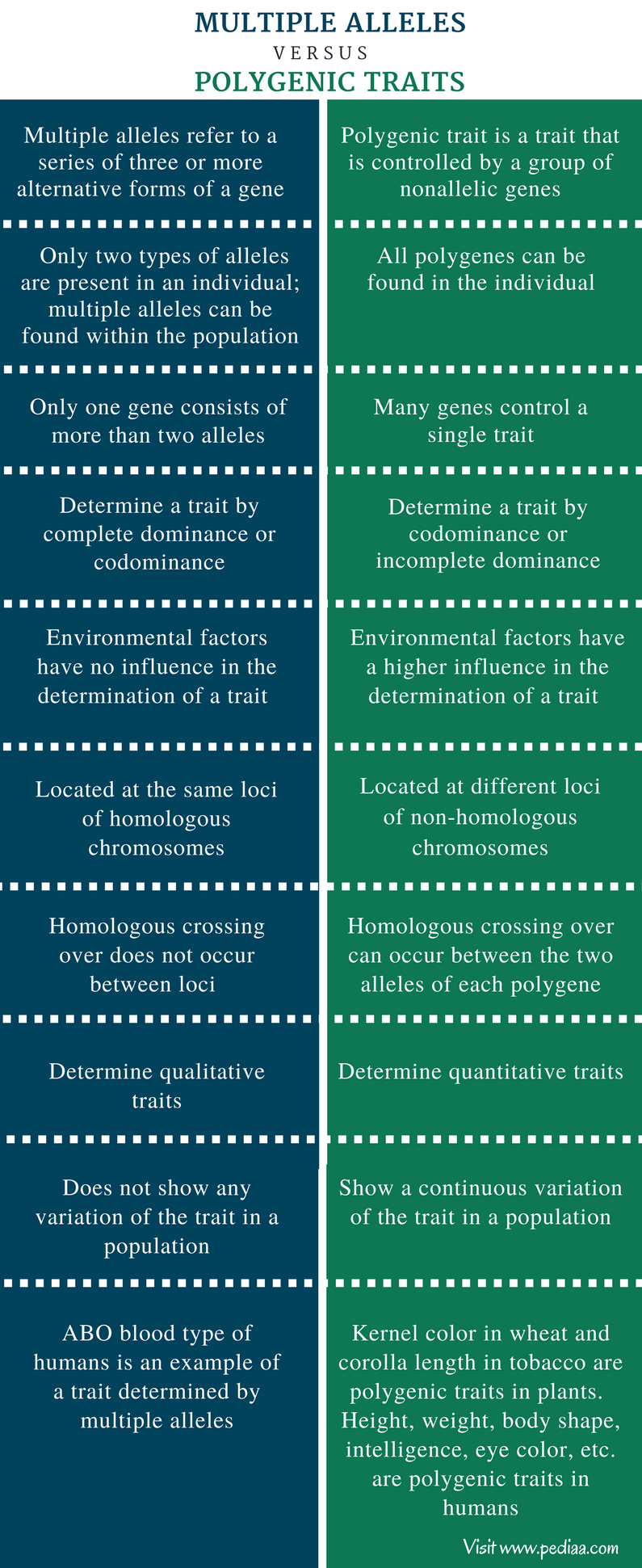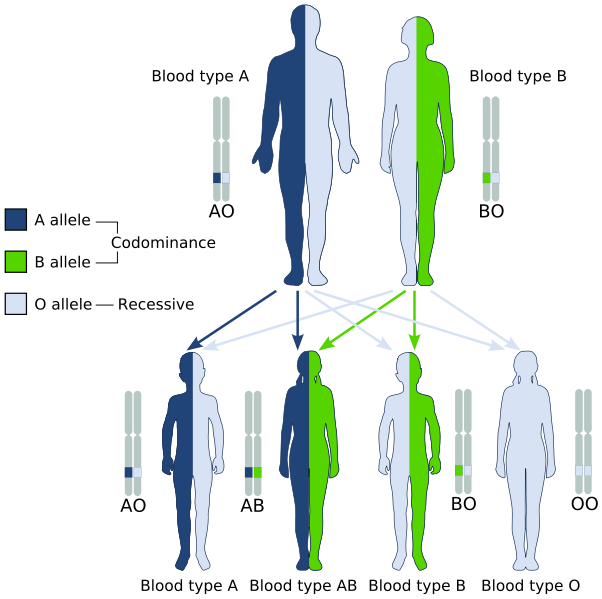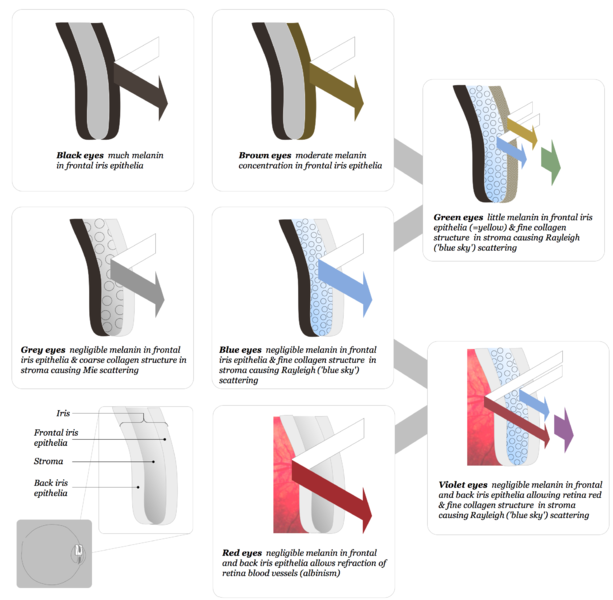Multiple Alleles Definition Biology Example
Main Difference – Multiple Alleles vs Polygenic Traits
Multiple alleles and polygenic traits are two types of non-Mendelian inheritance patterns where many factors are involved in determining a particular trait. In Mendelian inheritance, only two factors are involved in the determination of a particular trait. Multiple alleles are more than two alternative forms of a single gene, which are located at the same loci of homologous chromosomes. Polygenic traits are determined by several genes. The main difference between multiple alleles and polygenic traits is that multiple alleles are involved in the determination of a single trait by complete dominance or codominance whereas polygenic traits determine a particular trait in a population by codominance or incomplete dominance of each polygene.
Key Areas Covered
1. What are Multiple Alleles
– Definition, Features, Examples
2. What are Polygenic Traits
– Definition, Features, Examples
3. What are the Similarities Between Multiple Alleles and Polygenic Traits
– Outline of Common Features
4. What is the Difference Between Multiple Alleles and Polygenic Traits
– Comparison of Key Differences
Key Terms: Blood Types, Codominance, Complete Dominance, Dominant Alleles, Homologous Chromosomes, Incomplete Dominance, Multiple Alleles, Non-Mendelian inheritance, Polygenic Traits, Recessive Alleles

What are Multiple Alleles
Multiple alleles are the alternative forms of a gene when a particular gene comprises more than two alleles. Typically, every gene comprises two alternative forms: the dominant allele and the recessive allele. However, some genes comprise more than two alleles. Multiple alleles are situated at the same locus of homologous chromosomes. Homologous crossing over does not occur between homologous chromosomes containing alleles of the same gene. The influence of multiple alleles is on a single trait. Comprising of multiple alleles for a particular gene is a type of non-Mendelian inheritance pattern. Multiple alleles may produce either codominance or incomplete dominance patterns. Thus, a mixture of phenotypes can be visible in the offspring. A mixed type of dominant phenotypes can be observed in codominance while a blend of phenotypes can be observed in incomplete dominance.

Figure 1: Inheritance of ABO blood types
The human blood type is determined by multiple alleles. Four blood types can be identified in humans: type A, type B, type AB, and type O. Three allele types are involved in determining the blood type; IA, IB, and i. The type A blood is determined by the combination of two alleles, IAIA or IAi. The type B blood is determined by the combination of two alleles, IBIB or IBi. The type AB blood, which is determined by a combination of IAIB alleles, is an example of codominance in which both IA and IB alleles are expressed in equal dominance. The type O blood is determined by the combination of two recessive alleles, ii. The type A, B, and O are examples of complete dominance that follows Mendel's Laws of inheritance. The inheritance of ABO blood types in humans is shown in figure 1.
What are Polygenic Traits
A trait that is controlled by more than one gene is referred to as a polygenic trait. Each gene is located in different loci of different chromosomes. Polygenic traits are a type of non-Mendelian inheritance. The polygenic traits show a continuous variation of the character. Thus, polygenes show incomplete dominance. The distribution curve of the polygenic inheritance is bell-shaped. Polygenes show a great significance in evolution since they produce many different genotypes. The polygenic traits highly depend on external environmental factors.

Figure 2: Human eye color
The kernel color in wheat and corolla length in tobacco are examples of polygenic traits in plants. Most of the quantitative traits such as the height, weight, body shape, behavior, intelligence, eye color, skin color, and hair color of humans are controlled by polygenes. Sixteen different genes are involved in determining the amount of melanin produced in the iris of the eye, which ultimately produces the color of the eye. Depending on the amount of melanin produced in the iris, different eye colors can be identified among humans such as black, brown, green, hazel, and blue. The hazel color eyes are shown in figure 2.
Similarities Between Multiple Alleles and Polygenic Traits
- Both multiple alleles and polygenic traits are the examples of non-Mendelian inheritance patterns.
- More than two factors are involved in the determination of a trait in multiple alleles and polygenic traits.
Difference Between Multiple Alleles and Polygenic Traits
Definition
Multiple Alleles: Multiple alleles refer to a series of three or more alternative forms of a gene.
Polygenic Traits: Polygenic trait is a trait that is controlled by a group of nonallelic genes.
Presence in an Individual
Multiple Alleles: Only two types of alleles are present in an individual; multiple alleles can be found within the population.
Polygenic Traits: All polygenes can be found in the individual.
Number of Genes Involved
Multiple Alleles: Only one gene consists of more than two alleles.
Polygenic Traits: In polygenic traits, many genes control a single trait.
Mechanism
Multiple Alleles: Multiple alleles determine a trait by complete dominance or codominance.
Polygenic Traits: Polygenic traits determine a trait by codominance or incomplete dominance.
Influence of the Environmental Factors on a Trait
Multiple Alleles: Environmental factors have no influence in the determination of a trait by multiple alleles.
Polygenic Traits: Environmental factors have a higher influence in the determination of a trait by polygenes.
Location
Multiple Alleles: Multiple alleles are located at the same loci of homologous chromosomes.
Polygenic Traits: The polygenes are located at different loci of non-homologous chromosomes.
Crossing Over
Multiple Alleles: Homologous crossing over does not occur between the loci of multiple alleles.
Polygenic Traits: Homologous crossing over can occur between the two alleles of each polygene.
Qualitative/Quantitative
Multiple Alleles: Multiple alleles determine qualitative traits.
Polygenic Traits: Polygenic traits determine quantitative traits.
Variation in a Population
Multiple Alleles: Multiple alleles does not show any variation of the trait in a population.
Polygenic Traits: Polygenic traits show a continuous variation of the trait in a population.
Examples
Multiple Alleles: The ABO blood type of humans is an example of a trait determined by multiple alleles.
Polygenic Traits: The kernel color in wheat and corolla length in tobacco are the examples of polygenic traits in plants. The height, weight, body shape, behavior, intelligence, eye color, skin color, and hair color of humans are polygenic traits.
Conclusion
Multiple alleles and polygenic traits are two types of non-Mendelian inheritance. Thereby, more than two factors are involved in the determination of a trait in both multiple alleles and polygenic traits. Multiple alleles are more than two alternative forms of a gene, located at the same loci of homologous chromosomes. In polygenic traits, several genes are involved in determining a single trait. Multiple alleles follow complete dominance or codominance while polygenic traits follow codominance or incomplete dominance. Therefore, a continuous variation of a trait can be found in a population in polygenic traits. The main difference between multiple alleles and polygenic traits is the mechanism of inheritance of characters in multiple alleles and polygenic traits.
Reference:
1. Scoville, Heather. "Learn About Multiple Alleles." ThoughtCo. N.p., n.d. Web. Available here. 14 July 2017.
2. "Multiple Alleles: Meaning, Characteristics and Examples | Genes." Biology Discussion. N.p., 12 July 2016. Web. Available here. 14 July 2017.
3. "Polygenic Traits: Introduction, Features and Analysis | Genetics." Biology Discussion. N.p., 12 July 2016. Web. Available here. 14 July 2017.
4. "What are Polygenic Traits?" Bright Hub. N.p., 30 July 2010. Web. Available here. 14 July 2017.
Image Courtesy:
"ABO system codominance" By GYassineMrabetTalk- Own work based on Codominant.jpg, Public Domain) via Commons Wikimedia
"Human eye color" By Dipoar – Own work (CC BY-SA 3.0) via Commons Wikimedia

Multiple Alleles Definition Biology Example
Source: https://pediaa.com/difference-between-multiple-alleles-and-polygenic-traits/